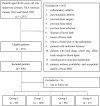Obesity and hyperlipidemia were associated with more severe synovitis and structural abnormalities as well as inferior functional outcomes in knee osteoarthritis: a retrospective comparative study
- PMID: 39696586
- PMCID: PMC11657670
- DOI: 10.1186/s13018-024-05326-2
Obesity and hyperlipidemia were associated with more severe synovitis and structural abnormalities as well as inferior functional outcomes in knee osteoarthritis: a retrospective comparative study
Abstract
Background: Considering that the respective effects of obesity and hyperlipidemia on knee osteoarthritis (OA) have not been fully investigated, the purpose of this study was to determine the relationship of obesity or hyperlipidemia with the synovitis and structural abnormalities of knee OA, and the effect of obesity and hyperlipidemia on functional outcomes of total knee arthroplasty.
Methods: There were 99 OA patients without obesity and hyperlipidemia in Group 1, 100 OA patients only with obesity in Group 2, 98 OA patients only with hyperlipidemia in Group 3, and 97 OA patients with both obesity and hyperlipidemia in Group 4. Semi-quantitative synovial inflammatory markers were measured including effusion-synovitis, size and intensity of infrapatellar fat pad abnormality, and synovial proliferation score. The structural abnormalities of knee OA were evaluated using Whole-Organ Magnetic Resonance Imaging Score (WORMS). Functional outcomes were evaluated before surgery and at 2 years follow-up.
Results: There were significantly higher effusion-synovitis, size and intensity of infrapatellar fat pad abnormality, and synovial proliferation score, as well as higher cartilage, bone marrow edema, meniscus, and total WORMS scores in Group 2, Group 3, and Group 4 (P < 0.05), but with no significant difference between Group 2 and Group 3 (P > 0.05). Group 2, Group 3, Group 4 had significantly worse Western Ontario and McMaster Universities Osteoarthritis Index, Forgotten Joint Score, Oxford Knee Score, Knee Society Score at baseline and 2 years follow-up (P < 0.05), but with no significant difference between Group 2 and Group 3 (P > 0.05). There were significant associations of obesity or hyperlipidemia with all synovial inflammatory markers and cartilage, bone marrow edema, meniscus, and total WORMS scores as well as functional outcomes (P < 0.05).
Conclusions: Obesity and hyperlipidemia were associated with more severe synovitis and structural abnormalities of knee OA, as well as inferior preoperative and postoperative functional outcomes. The negative effects of obesity and hyperlipidemia on knee OA could be mutually enhanced. The findings emphasized the negative effects of obesity and hyperlipidemia on the symptoms and outcomes of knee OA, and highlighted the association of obesity and hyperlipidemia with synovitis.
Keywords: Functional outcomes; Hyperlipidemia; Obesity; Osteoarthritis; Structural abnormalities; Synovitis.
© 2024. The Author(s).
Conflict of interest statement
Declarations. Ethics approval and consent to participate: This study was approved by Institutional Review Board of Hebei medical university third hospital and followed the Declaration of Helsinki. Informed consent was obtained from all patients. Consent for publication: Written informed consent was obtained from all patients to authorize the publication of their data. Competing interests: The authors declare no competing interests.
Figures






Similar articles
-
Associations Between Knee Effusion-synovitis and Joint Structural Changes in Patients with Knee Osteoarthritis.J Rheumatol. 2017 Nov;44(11):1644-1651. doi: 10.3899/jrheum.161596. Epub 2017 Sep 1. J Rheumatol. 2017. PMID: 28864651 Clinical Trial.
-
Is treated HIV infection associated with knee cartilage degeneration and structural changes? A longitudinal study using data from the osteoarthritis initiative.BMC Musculoskelet Disord. 2019 May 4;20(1):190. doi: 10.1186/s12891-019-2573-5. BMC Musculoskelet Disord. 2019. PMID: 31054571 Free PMC article.
-
Quantitative magnetic resonance imaging evidence of synovial proliferation is associated with radiographic severity of knee osteoarthritis.Arthritis Rheum. 2011 Oct;63(10):2983-91. doi: 10.1002/art.30471. Arthritis Rheum. 2011. PMID: 21647860 Free PMC article.
-
Nonsurgical Knee Osteoarthritis Treatments for Reducing Inflammation as Measured on MRI Scans: A Systematic Review of Randomized Controlled Trials.Orthop J Sports Med. 2024 Dec 12;12(12):23259671241272667. doi: 10.1177/23259671241272667. eCollection 2024 Dec. Orthop J Sports Med. 2024. PMID: 39678436 Free PMC article. Review.
-
Imaging-based measures of synovitis in knee osteoarthritis: A scoping review and narrative synthesis.Osteoarthr Cartil Open. 2025 Mar 24;7(2):100602. doi: 10.1016/j.ocarto.2025.100602. eCollection 2025 Jun. Osteoarthr Cartil Open. 2025. PMID: 40235523 Free PMC article. Review.
Cited by
-
Expanding the Horizon of Multidisciplinarity: Incorporating Biomechanical, Metabolic, and Functional Factors Into Registry-Based Research to Predict Subsequent Risk for Total Knee Arthroplasty.Arthroplast Today. 2025 Apr 25;33:101697. doi: 10.1016/j.artd.2025.101697. eCollection 2025 Jun. Arthroplast Today. 2025. PMID: 40342541 Free PMC article. No abstract available.
-
Non-linear associations between blood glucose, blood lipids and inflammatory markers and new-onset arthritis in the middle-aged and older population - a cohort study in Europe.Lipids Health Dis. 2025 Mar 1;24(1):79. doi: 10.1186/s12944-025-02495-9. Lipids Health Dis. 2025. PMID: 40025473 Free PMC article.
References
Publication types
MeSH terms
LinkOut - more resources
Full Text Sources
Medical

